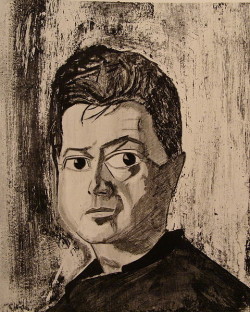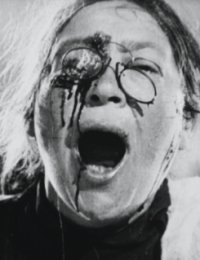
Portrait of Francis Bacon, Reginald Gray, oil on board, 1960. Source: Wikimedia Commons.
There is a grim high seriousness to the work of Francis Bacon, but it is a seriousness streaked with redemption, a formulation not so much of useless despair in an alienating society as of the humanizing effect of terror and suffering. The tension between horror and integrity is perhaps what makes it so appealing to the Soviet Union.
The Sotheby’s sale in Moscow in July established the British, in whom the Russians have historically had little interest, as great publicists, capable of focusing Western attention and capital on Soviet. And the Moscow exhibition of the paintings of Francis Bacon, on view since 22 September, has shown that British and Soviet artistic concerns are not wholly alien to one another. This show is a step toward greater sympathy between the artistic communities of two countries in which literature has tended to assume primacy.
The story behind the exhibition is a tangled one. James Birch, a British gallerist, having failed to get New York galleries to show the work of any of the artists he represents, was at a drinks party in London at which a carpet broker “with many contacts in the Eastern Bloc” suggested to him that “Moscow might be easier”; armed with that advice, he set off for the Soviet Union to arrange an exhibition of his artists. This ill-advised effort was unsuccessful, but various Soviet officials and several official artists in the USSR indicated that they were fascinated by the work of Francis Bacon and would like to seen an exhibition of it. Birch came back and reported this to Bacon, who was delighted, and the British Council, in cooperation with the Marlborough Gallery, subsequently launched the effort to exhibit his paintings. The prime mover behind the show from the Soviet side has been Sergei Klokov, a charming and committed man who works with UNESCO and helped to arrange the invitation from the Union of Artists of the USSR. It is significant that the exhibition has been arranged by the Union rather than by the Ministry of Culture, and that it will be held in the Central House of the Union of Artists; the arrangements for such a show would until recently have been prohibitively complicated, involving desperately protracted bureaucratic negotiation. Though the exhibition has unfortunately been edited – several works were eliminated on grounds that they were “too pornographic” – it is essentially representative of the work of a contemporary Western artist, and as such is another landmark victory of perestroika.
The exhibition includes twenty-two paintings, spanning Bacon’s career, but it emphasizes recent work; more than a third of the paintings included have been done since 1980. The accompanying catalogue, published in Russian by Marlborough and the British Council, contains two essays. In the first, Lord Gowrie, chairman of Sotheby’s, attempts to explain Bacon’s frame of reference to the Soviets, with whom he has had some contact. In the second, the Soviet art historian M.N. Sokolov, who is well-acquainted with the Soviet viewing public and its difficulties with contextualization, provides Soviet insights into Bacon’s work. Gowrie’s essay is intelligent but confusing, littered with difficult references. Sokolov’s essay is more convincing; it picks out the Russian strengths in Bacon’s work and describes them in the language of Dostoevsky. Sokolov paints an entire career for Bacon, recounting a young spent indecisive and afraid in the decadence of Berlin and a maturity spent tracing the terrors of the mind. Again and again, Sokolov identifies what should be accessible to Soviets in Bacon’s works. He describes a postwoman who delivered a Bacon catalogue that “reminded her of Gogol’s tragi-comic satire.” He recalls the great dialogue of Raskolnikov and Svidrigailov, in which the idea of eternity as something vast gives way to “a bath-hut, blackened by smoke, and in all the corners – spiders, and that is all your eternity.” The effect of these references is not to diminish Bacon, but to elucidate his obsession with the grand emotions, stressing that it is no less eloquent because it is couched in then language of the nervous system rather than that of the soul. What most needs translating in Bacon’s work, for the Soviets, is its scale, and this is precisely where Sokolov is triumphant.
Bacon turned seventy-seven at the end of October; as his work becomes more introspective, the curatorial impulse to organize retrospectives grows stronger, and the Moscow show, with a modest twenty-two paintings, foreshadows the larger exhibitions scheduled for 1989 in Washington, Los Angeles, and New York. It is time to find coherence in his work, elucidating constants and noting changes.

Scene from the massacre on the Odessa Steps. From The Battleship Potemkin, by Sergei Eisenstein (1925)
In two of the first paintings in the Moscow exhibition, Head VI and Study for the Nurse in the Film “Battleship Potemkin,” Bacon explores the image from Sergei Eisenstein’s film of 1925 that he has described as one of the great influences on his work. That the reference is to the work of a Soviet filmmaker makes the emphasis all the more apposite in this exhibition. Bacon has always kept a copy of the film still of the screaming nurse in his studio; Eisenstein’s portentous despair mirrored his own, and the abrupt and terrifying moment of knowledge that torments the nurse at her death is one that recurs throughout Bacon’s work. The figure in Head VI, indebted to Eisenstein, recalls Munch’s The Scream as much as the Velázquez it more obviously mimics; the relentless open mouth is like an unstoppable cavity in the in the middle of the canvas, and box containing the figure, exaggerates the futility of the suffering without decreasing the suffering itself. This painting, like the famous and closely related series of paintings of popes that followed it, is at once despairing and impersonal.
By the early sixties, Bacon was turning from such impersonal and referential images to portraits of friends. His many paintings of George Dyer, his long-time lover, and of his friends Isabel Rawsthorne, Muriel Belcher, and Lucien Freud are more intimate than the earlier work, uncomfortable as much because they probe their subjects too closely as because of what that probing reveals. In paintings like Portrait of George Dyer Crouching and Portrait of George Dyer Staring at a Blind, Bacon discovers poignancy in the isolation of the naked figure. This is not the shattering despair of the earlier work, but a disquieting sense of isolation. In Studies of George Dyer and Isabel Rawsthorne, the faces have softened and blurred. They are pulled unnaturally close together, closer than conversation would warrant, but they are still unconnected, and her delicate, hooded eyes seem to see nothing. It is the painter who intrudes here, sustaining his position as the only locus of mutuality. The painting is about sadness; though there is less drama than in Head VI, there is still a lacuna.
The position of the artist as observer has become more and more important to Bacon’s work; indeed it is the central motif of much of his recent painting. After the death of George Dyer in 1971, Bacon painted his three “black triptychs,” in which the inhuman scale of loss itself takes control of the figures. In the first of these paintings, the figures are motionless before the cavernous black doors; in the second, they have moved into those empty spaces; and in the third, the powerful figure in the center emerges from the darkness to stand beneath a bright bulb, a butcher to his right and a photographer to his left. Loss gives way to absence that emerges as newly strengthened presence in the face of the artist and the tormentor. This essential progression can be seen repeatedly in Bacon’s work.
In his paintings of the eighties, Bacon has achieved all the softened maturity of retrospect. The figures are less harsh and less distorted, and the geometries that circumscribe them are less prone to interfere with their wholeness. In Three Studies for a Portrait of John Edwards, Bacon touched his current companion with a composure only granted to George Dyer after his death. Even in a major work like Triptych Inspired by the Oresteia of Aeschylus, where such old motifs as doors opening to blackness and the headless trunk enthroned in majesty are in evidence, there is a formal balance, and the central figure has the dignity of those who choose not resist an inexorable fate.
Bacon has spoken more about his work and about the process of painting than has almost any artist of the twentieth century. “Great art,” he once said, “is always a way of concentrating, reinventing what is called fact, what we know of our existence – a reconcentration… tearing away the veils that fact acquires through time. Ideas always acquire appearance veils, the attitude people acquire of their time and earlier time. Really good artists tear down those veils.” Bacon’s work does just that, revealing itself as an agonized struggle to identify the disparity between inner and outer truth and at the same time to find a formal construct in which that disparity has meaning. Such patient suffering seems likely to find sympathy among the Soviets; and to them it will seem reasonable that the miseries of youth, dramatic and situational, gave way to the deeper sadnesses of middle life and ultimately to the resignation and introspection of old age. The progression is one that recurs in Russian literature, of course; it is also not entirely alien to the recent development of the Soviet vanguard, which, having won certain politicized triumphs, is now beginning to turn back in upon itself. The Soviets have matured in the wake of glasnost and perestroika. They have not received this exhibition with the naiveté brought to Warhol’s work when it came to Moscow some years ago; instead, they have looked at it with respect and dignity born of mutual resignation to the existential fallacy. The discontinuities of language are what make the art interesting to them: here is what often was thought, but never expressed with such surprising and particular poignancy.
In his introduction to the Moscow catalogue, Lord Gowrie quotes Bacon as saying that the purpose of art is joy. But what kind of joy is expressed in his work, which is sometimes poignant but so often agonized? Perhaps it is the joy of seeing the world for what it is and surviving to recount it. Describing the difficulties of painting a portrait, Bacon recently said, “the problem… was how to make an image and keep the likeness.” The joy lies not so much in success at this undertaking, which is never more than partial, but in having the integrity to imagine and then to attempt such singular clarity.











